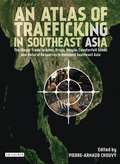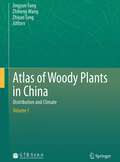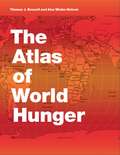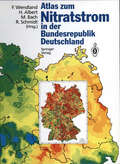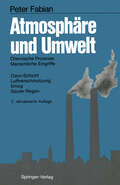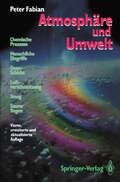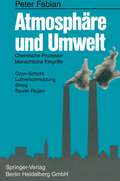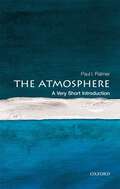- Table View
- List View
An Atlas of Trafficking in Southeast Asia: The Illegal Trade in Arms, Drugs, People, Counterfeit Goods and Natural Resources in Mainland Southeast Asia (International Library Of Human Geography Ser.)
by Pierre-Arnaud ChouvyMainland Southeast Asia is one of the world's key regions for the smuggling and trafficking of illegal goods. Armed conflict in the region has spurred an international trade in small arms, and organized nuclear smuggling rings are now believed to operate as well. Human trafficking is widespread, with children being especially vulnerable either for slave labour or sexual exploitation. The region is being flooded with contraband and counterfeit goods such as pirated movies, designer label clothes and currency, especially US dollars, whilst antiques, oil and medicinal drugs - counterfeit as well as authentic ones - are also being smuggled.While such activity has been drawing increased attention, the scope, nature and mechanisms of smuggling and trafficking across the region are far from understood. Even less is known about the various synergies that may exist between the different trafficking activities. An Atlas of Trafficking in Southeast Asia brings together a team of key researchers and cartographic specialists to provide a unique overview of the major forms of illegal trafficking in the region. The contributors have been drawn from a range of disciplines, reflecting the complex reality of this diverse and thriving illegal economy. Geographer Pierre-Arnaud Chouvy provides a history of the drug trafficking routes in and out of the Golden Triangle, whose opium and heroin networks have played such a significant role in both the regional and global history. Anthropologist David Feingold, focuses on human smuggling and trafficking, a highly complex trade with many causes and consequences, whilst political scientist David Capie examines the illegal trade in small arms. There has been impressive rhetoric about the need to tackle the illicit arms trade but much less in the way of practical action. Southeast Asia has the highest rate of deforestation of any major tropical region, whilst wildlife is currently being extracted at six times the sustainable rate. Vanda Felbab-Brown, also a political scientist, examines the key interrelated topics of illegal logging and wildlife trafficking. Finally, journalist Bertil Lintner surveys the trade in counterfeit goods and contraband, two thriving activities in mainland Southeast Asia. Accompanying the text is a unique series of thirty-two full-colour maps. These maps have been especially drawn for the atlas and detail the trafficking hubs, counter-trafficking facilities and border status for each of the trafficking activities. Political, historical, topographic, ecological and linguistic regional maps are also included. An Atlas of Trafficking in Southeast Asia sheds valuable light on the complex and shadowy world of one of the key regions for illegal trading. An unparalleled reference resource, it will be welcomed by professionals and academics across a wide range of disciplines.
Atlas of Typical Seismic and Geological Sections for Major Petroliferous Basins in China (SpringerBriefs in Earth Sciences)
by Shouli QuThis book offers readers a comprehensive introduction to the seismic and geological response characteristics of major tectonic types, typical reservoirs, and typical geological bodies in China, illustrated in diagrams. The book is divided into four sections, the first of which covers the typical structural styles of petroliferous basins in China. The second focuses on the seismic response of typical stratigraphic and sedimentary features. The third section addresses the seismic response characteristics of clastic geological bodies such as fan bodies, river phase sand bodies, and delta sand bodies, while the fourth describes three typical oil and gas reservoirs
Atlas of Woody Plants in China: Distribution and Climate
by Jingyun Fang Zhiheng Wang Zhiyao Tang"Atlas of Woody Plants in China: Distribution and Climate” documents the spatially-explicit county-level distribution of all 11,405 woody plants in China, together with life form information for most species. It also provides climate information for each species, with the county-level average and range of 12 climatic indices and of vegetation net primary productivity. It is the first and largest comprehensive atlas in the world for the distribution of China’s plants and was compiled on the basis of almost all related literature published throughout China. The atlas should serve as an indispensable handbook for all those who are interested in the plants, ecology, geography, environment, horticulture, and silviculture of China and East Asia. Dr. Jingyun Fang is a Cheung Kong Professor at the Department of Ecology, Peking University, China. Dr. Zhiheng Wang and Dr. Zhiyao Tang are both ecologists working at the same institute.
An Atlas of World Affairs
by Andrew Boyd Joshua ComenetzThe economic, social and environmental systems of the world remain in turmoil. Recent years have seen possibly irrevocable change in the politics of Europe, Asia, Africa and Latin America. This entirely revised and updated 11th edition describes the people, factions, and events that have shaped the modern world from the Second World War to the present day. International issues and conflicts are placed in their geographical contexts through the integration of over one hundred maps. The political context provided for current events will be invaluable to all those uncertain about the changing map of Europe and Africa, conflicts in the Middle East, and the appearances in the headlines and on our television screens by al-Qaeda, Chechnya, the Taliban, Mercosur, Somaliland, Kosovo, AIDS, OPEC, and Schengenland. Critical new issues are covered including the war on terrorism, nuclear proliferation, European Union expansion, and the pressing environmental concerns faced by many sovereign states. This edition provides guidance through all these recent changes (and many more). This book offers up-to-date coverage of all regions in great detail. It contains an objective and concise explanation of current events, combining maps with their geopolitical background. It provides a clear context for events in the news, covering the Middle East, Korea, China, the European Union, east Africa, and every other part of the world. Revised and in print since 1957, An Atlas of World Affairs continues to provide a valuable guide for the student, teacher, journalist and all those interested in current affairs and post-war political history.
An Atlas of World Affairs
by Andrew Boyd Joshua ComenetzThe economic, social and environmental systems of the world remain in turmoil. Recent years have seen possibly irrevocable change in the politics of Europe, Asia, Africa and Latin America. This entirely revised and updated 11th edition describes the people, factions, and events that have shaped the modern world from the Second World War to the present day. International issues and conflicts are placed in their geographical contexts through the integration of over one hundred maps. The political context provided for current events will be invaluable to all those uncertain about the changing map of Europe and Africa, conflicts in the Middle East, and the appearances in the headlines and on our television screens by al-Qaeda, Chechnya, the Taliban, Mercosur, Somaliland, Kosovo, AIDS, OPEC, and Schengenland. Critical new issues are covered including the war on terrorism, nuclear proliferation, European Union expansion, and the pressing environmental concerns faced by many sovereign states. This edition provides guidance through all these recent changes (and many more). This book offers up-to-date coverage of all regions in great detail. It contains an objective and concise explanation of current events, combining maps with their geopolitical background. It provides a clear context for events in the news, covering the Middle East, Korea, China, the European Union, east Africa, and every other part of the world. Revised and in print since 1957, An Atlas of World Affairs continues to provide a valuable guide for the student, teacher, journalist and all those interested in current affairs and post-war political history.
The Atlas of World Hunger
by Thomas J. Bassett Alex Winter-NelsonEarlier this year, President Obama declared one of his top priorities to be “making sure that people are able to get enough to eat.” The United States spends about five billion dollars on food aid and related programs each year, but still, both domestically and internationally, millions of people are hungry. In 2006, the Food and Agricultural Organization of the United Nations counted 850 million hungry people worldwide, but as food prices soared, an additional 100 million or more who were vulnerable succumbed to food insecurity. If hunger were simply a matter of food production, no one would go without. There is more than enough food produced annually to provide every living person with a healthy diet, yet so many suffer from food shortages, unsafe water, and malnutrition every year. That’s because hunger is a complex political, economic, and ecological phenomenon. The interplay of these forces produces a geography of hunger that Thomas J. Bassett and Alex Winter-Nelson illuminate in this empowering book. The Atlas of World Hunger uses a conceptual framework informed by geography and agricultural economics to present a hunger index that combines food availability, household access, and nutritional outcomes into a single tool—one that delivers a fuller understanding of the scope of global hunger, its underlying mechanisms, and the ways in which the goals for ending hunger can be achieved. The first depiction of the geography of hunger worldwide, the Atlas will be an important resource for teachers, students, and anyone else interested in understanding the geography and causes of hunger. This knowledge, the authors argue, is a critical first step toward eliminating unnecessary suffering in a world of plenty.
The Atlas of World Hunger
by Thomas J. Bassett Alex Winter-NelsonEarlier this year, President Obama declared one of his top priorities to be “making sure that people are able to get enough to eat.” The United States spends about five billion dollars on food aid and related programs each year, but still, both domestically and internationally, millions of people are hungry. In 2006, the Food and Agricultural Organization of the United Nations counted 850 million hungry people worldwide, but as food prices soared, an additional 100 million or more who were vulnerable succumbed to food insecurity. If hunger were simply a matter of food production, no one would go without. There is more than enough food produced annually to provide every living person with a healthy diet, yet so many suffer from food shortages, unsafe water, and malnutrition every year. That’s because hunger is a complex political, economic, and ecological phenomenon. The interplay of these forces produces a geography of hunger that Thomas J. Bassett and Alex Winter-Nelson illuminate in this empowering book. The Atlas of World Hunger uses a conceptual framework informed by geography and agricultural economics to present a hunger index that combines food availability, household access, and nutritional outcomes into a single tool—one that delivers a fuller understanding of the scope of global hunger, its underlying mechanisms, and the ways in which the goals for ending hunger can be achieved. The first depiction of the geography of hunger worldwide, the Atlas will be an important resource for teachers, students, and anyone else interested in understanding the geography and causes of hunger. This knowledge, the authors argue, is a critical first step toward eliminating unnecessary suffering in a world of plenty.
Atlas zum Nitratstrom in der Bundesrepublik Deutschland: Rasterkarten zu geowissenschaftlichen Grundlagen, Stickstoffbilanzgrößen und Modellergebnissen
by R. Becker S. Biermann K. Großmann I. Hiller K. J. Hülsbergen R. Michel A. Schumacher U. SturmAtmosphäre und Umwelt: Chemische Prozesse · Menschliche Eingriffe Ozon-Schicht · Luftverschmutzung Smog · Saurer Regen
by Peter FabianAtmosphäre und Umwelt: Chemische Prozesse - Menschliche Eingriffe - Ozon-Schicht - Luftverschmutzung Smog - Saurer Regen
by Peter FabianUnsere Atmosphäre, das Luftmeer, auf dessen Grunde wir leben, ist ein Gasgemisch, das neben den Hauptbestandteilen Stickstoff und Sauerstoff eine Vielzahl von Spurengasen enthält. Dieses Gasgemisch an sich wäre reaktionsträge und somit von geringem chemischen Interesse, würde es nicht im Wechsel von Tag und Nacht und im Rhythmus der Jahreszeiten von der Sonne bestrahlt. Die Sonnenstrahlung, insbesondere ihr energie reicher Ultraviolettanteil, vermag die meisten Konstituenten des atmo sphärischen Gasgemisches in ihre Bestandteile zu spalten. Durch diesen photochemischen Prozeß, den man als "Photolyse" oder "Photodissozia tion" bezeichnet, entstehen äußerst reaktive Substanzen, die für uns Erdbewohner wichtige chemische Reaktionsketten auslösen. Lediglich die atmosphärischen Edelgase, Argon, Neon, Helium und Krypton (in der Reihenfolge ihrer Häufigkeit) nehmen an diesen Prozessen nicht teil. Der wohl wichtigste photochemische Prozeß in unserer Atmosphäre ist die Bildung von Ozon (s. Abschnitt 2). Ozon ist die dreiatomige Form des Luftsauerstoffs, 0 • Der normale Sauerstoff besteht aus O , zwei mit 3 2 einander verbundenen Sauerstoff-Atomen. Unter Einwirkung der Ultra violettstrahlung der Sonne wird ein Teil des Luftsauerstoffs O gespalten, 2 und die gebildeten Sauerstoffatome können sich mit zweiatomigen Sauer stoffmolekülen zum dreiatomigen Ozon verbinden. Die hieraus resultie rende atmosphärische Ozonschicht ist für uns in zweifacher Hinsicht von großer Bedeutung. Zum einen schirmt sie die gefährliche Ultraviolett strahlung der Sonne ab, welche ohne diesen Filter alles Leben auf dem Festland auslöschen würde. Zum anderen bewirkt die Energie dieser in der Höhe absorbierten Strahlung dort eine beachtliche Erwärmung, sie hat damit Einfluß auf die allgemeine Luftzirkulation.
Atmosphäre und Umwelt: Chemische Prozesse · Menschliche Eingriffe · Ozon-Schicht · Luftverschmutzung · Smog · Saurer Regen
by Peter FabianEin allgemeinverständlicher Überblick über die Vorgänge in der Athmosphäre und die Auswirkungen menschlicher Eingriffe auf das Ökosystem Erde.
Atmosphäre und Umwelt: Chemische Prozesse, Menschliche Eingriffe. Ozon-Schicht, Luftverschmutzung, Smog, Saurer Regen
by Peter FabianAtmosphärendynamik
by Ulrich AchatzDieses Lehrbuch richtet sich an Studierende der Meteorologie sowie an Forschende zu theoretischen und numerischen Aspekten von Wetter und Klima. Der vorliegende Text konzentriert sich auf das Wesentliche und bleibt dabei gleichermaßen gründlich. Alle zum Verständnis notwendigen physikalischen Konzepte werden eingeführt.Einleitend erfolgt eine Herleitung der Grundgleichungen der Atmosphärendynamik. Diese werden nachfolgend herangezogen, um wesentliche Aspekte von Wetter und Klima zu erläutern, zu denen unter anderem die Mechanismen hinter den wirbelartigen Bewegungen auf der täglichen Wetterkarte gehören. Als Mittel zu einer effizienten Analyse von atmosphärischen Wellen folgt die Vereinfachung der Dynamik mithilfe der Flachwassergleichungen. Daraufhin wird unter Zuhilfenahme der quasigeostrophischen Theorie das Auftreten extratropischer Wettersysteme begründet. Dem schließt sich eine ausführliche Betrachtung der globalen atmosphärischen Zirkulation an, die maßgeblich dem Einfluss durch Rossby- und Schwerewellen unterliegt. Auch die spezifischen Eigenschaften der atmosphärischen Grenzschicht werden diskutiert. Im Mittelpunkt steht hier die Wechselwirkung zwischen Turbulenz und mittlerer Strömung.Im Zuge der Betrachtungen wird die Leserschaft mit wesentlichen theoretischen Konzepten des Gebiets vertraut gemacht. Hierzu zählen Entropie und potentielle Temperatur, potentielle Vorticity, Instabilitätstheorie, Reynoldsgleichungen, Mehrskalenasymptotik, WKB-Theorie, Wellenwirkung, Eliassen-Palm-Fluss, transformiertes Eulermittel, kritische Schichten, Wellenbeugung und vieles mehr.Der Text wird durch Anhänge zu mathematischen Methoden und weiteren Vertiefungen ergänzt. Kapitelzusammenfassungen helfen, den Blick auf das Wesentliche zu bewahren. Ergänzende Leseempfehlungen regen dazu an, das erworbene Wissen zu vertiefen und zu erweitern.
Atmosphärische Ausbreitungsmodellierung: Grundlagen und Praxis
by Axel ZengerAtmosphärische Ausbreitungsmodellierungen werden heute nicht mehr ausschließlich von Meteorologen durchgeführt. Viele Stadt- oder Verkehrsplaner, Bauingenieure und Architekten setzen mittlerweile Ausbreitungsmodelle ein, um mögliche lufthygienische Auswirkungen ihrer Planungen schon im Vorfeld abschätzen zu können. Die Anwender verfügen aber oft nicht über das notwendige methodische und meteorologische Basiswissen. Dieses Wissen ist jedoch unabdingbar, um die verschiedenen Modellierungsansätze besser verstehen bzw. deren Einsatzmöglichkeiten und Zuverlässigkeit einschätzen zu können. Der Autor beschreibt anschaulich und mit einem Minimum an Formeln die physikalischen, meteorologischen und numerischen Grundlagen. An Beispielen wird gezeigt, wie Ausbreitungsrechnungen und Emmissionsprognosen durchzuführen sind. Die mitgelieferten Programme ermöglichen dabei die unmittelbare Umsetzung der dargestellten Sachverhalte.
Atmosphärische Optik für Einsteiger: Lichtspiele in der Luft
by Michael VollmerWir haben tagtäglich die atmosphärische Optik vor Augen - und übersehen sie geflissentlich. Dabei führt uns der Himmel anschaulich vor, was mit dem Licht passiert, wenn es an Wassertropfen oder Rauch gestreut wird und dort, wo eigentlich nichts ist als mehr oder weniger reine Luft, bunte Bilder an den Himmel zaubert. Sonnenuntergänge, Regenbögen, Polarlichter, Aureolen und Glorien - eine Art Hof oder Heiligenschein - oder Fata Morganas werden in Michael Vollmers reich illustriertem und klar verständlichem Buch zum natürlichen Labor für physikalische Entdeckungen - und man wird staunen, wie viel Physik man plötzlich kann - und die ist keine Fata Morgana.
The Atmosphere: A Very Short Introduction (Very Short Introductions)
by Paul I. PalmerThe atmosphere is the thin, diffuse fluid that envelops the Earth's surface. Despite its apparent fragility, the existence of this fluid is vital for human and other life on Earth. In this Very Short Introduction Paul Palmer describes the physical and chemical characteristics of different layers in the atmosphere, and shows how the interactions where the atmosphere is in contact with land, ocean, and ice affect its observed physical and chemical properties. He also looks at how movement in the atmosphere, driven by heat from the sun, transports heat from lower latitudes to higher latitudes, and is a fundamental feature of the general circulation in the atmosphere. Finally, Palmer presents an overview of the types of measurements used to understand different parts of the atmosphere, and identifies the future challenges for atmospheric scientists. ABOUT THE SERIES: The Very Short Introductions series from Oxford University Press contains hundreds of titles in almost every subject area. These pocket-sized books are the perfect way to get ahead in a new subject quickly. Our expert authors combine facts, analysis, perspective, new ideas, and enthusiasm to make interesting and challenging topics highly readable.
The Atmosphere: A Very Short Introduction (Very Short Introductions)
by Paul I. PalmerThe atmosphere is the thin, diffuse fluid that envelops the Earth's surface. Despite its apparent fragility, the existence of this fluid is vital for human and other life on Earth. In this Very Short Introduction Paul Palmer describes the physical and chemical characteristics of different layers in the atmosphere, and shows how the interactions where the atmosphere is in contact with land, ocean, and ice affect its observed physical and chemical properties. He also looks at how movement in the atmosphere, driven by heat from the sun, transports heat from lower latitudes to higher latitudes, and is a fundamental feature of the general circulation in the atmosphere. Finally, Palmer presents an overview of the types of measurements used to understand different parts of the atmosphere, and identifies the future challenges for atmospheric scientists. ABOUT THE SERIES: The Very Short Introductions series from Oxford University Press contains hundreds of titles in almost every subject area. These pocket-sized books are the perfect way to get ahead in a new subject quickly. Our expert authors combine facts, analysis, perspective, new ideas, and enthusiasm to make interesting and challenging topics highly readable.
Atmosphere and Climate: Studies by Occultation Methods
by Ulrich Foelsche Gottfried Kirchengast Andrea SteinerThis book presents carefully edited and peer-reviewed papers from the 2nd International Workshop on Occultations for Probing Atmosphere and Climate (OPAC-2), held in Graz, Austria. It starts with a general introductory paper and proceeds to address the full range from methodology in general via specific occultation methods (GNSS-LEO, LEO-LEO, stellar and solar) to the use of occultation data, with focus on atmospheric physics, meteorology and climate.
The Atmosphere and Ionosphere: Dynamics, Processes and Monitoring (Physics of Earth and Space Environments)
by Vladimir Bychkov Gennady Golubkov Anatoly NikitinFrom July 7 to 12, 2008 in Zelenogradsk, a cosy resort on the bank of the Baltic Sea near Kaliningrad in Russia, the 1st International Conference “Atmosphere, Ionosphere, Safety (AIS-2008)” has been carried out. The State Russian University of I. Kant, Semenov Institute of chemical physics of the Russian Academy of Sciences, Pushkov Institute of terrestrial magnetism and radio-waves propagation of the Russian Academy of Sciences, and Russian Committee on Ball Lightning (BL) have acted as organizers of the conference. Financial support was made by Russian Fund of Fundamental Research Project N. 08-03-06041 and European Of?ce of Aerospace Research and Development Grant award FA8655-08-1-5052. The International conference “Atmosphere, Ionosphere, Safety” (AIS-2008) was devoted to (i) the analysis of the atmosphere–ionosphere response on natural and man-made processes, the reasons of occurrence of the various accompanying geophysical phenomena, and an estimation of possible consequences of their in?uence on the person and technological systems; (ii) the study of the monitoring possibility and search of the ways for the risk level decrease. Discussion of the physical and chemical processes accompanying the observable geophysical p- nomena was undertaken. One can see from a list of the Conference sections that questions of safety took only rather modest place, so main topics of the Conference became discussion of processes taking place in the atmosphere, ionosphere and methods of monitoring these processes.
The Atmosphere and Ionosphere: Elementary Processes, Monitoring, and Ball Lightning (Physics of Earth and Space Environments)
by Vladimir L. Bychkov Gennady V. Golubkov Anatoly I. NikitinThis book presents a collection of reviews prepared for the conference “Atmosphere, Ionosphere, Safety,” held in Kaliningrad, Russia, in July 2012. It provides the reader insight into the current developments in the following fields: physics of elementary processes; ionosphere dynamics; ball lightning and aerosol structures; as well as remote detection of the radioactive and highly toxic substances. The diversity of scope presented offers readers an up-to-date overview of trends, questions and their solutions.
The Atmosphere and Ionosphere: Elementary Processes, Discharges and Plasmoids (Physics of Earth and Space Environments)
by Vladimir Bychkov, Gennady Golubkov and Anatoly NikitinThe book presents a collection of articles devoted to atmospheric and ionospheric science reported during the Conference “Atmosphere, Ionosphere, Safety” held in Kaliningrad, Russia in July 2010. It consists of reviews devoted to physics of elementary processes, aerosols, ionosphere dynamics, microwave discharges and plasmoids. Such a wide range of topics presents a comprehensive analysis of this atmospheric science including trends and questions which exist to be solved.
The Atmosphere and Ocean: A Physical Introduction (Advancing Weather and Climate Science #5)
by Neil C. WellsThe Atmosphere and Ocean is a fully revised and updated student friendly physical introduction to the atmosphere and ocean. Now in its Third Edition, the book continues to provide students with an accessible description of the atmosphere and ocean with emphasis on their physical properties and inter-dependence. Clearly structured throughout, the book demonstrates that the atmosphere and ocean are both subject to the influence of the earth's rotation and therefore they have a common dynamical basis. The author clearly demonstrates the fundamental differences between the two environments and provides the reader with a much better understanding of the atmosphere and the ocean and an appreciation of their closest interactive relationship. There have been many developments in the field over the past ten years and this latest edition of a highly successful textbook brings together new material on the ocean-atmosphere system and climate, the observed circulation of the atmosphere and ocean and radiation in the atmosphere and ocean. Fully revised and updated 3rd Edition of student friendly physical introduction to the atmosphere and ocean. Now includes new chapters on observed circulation of the atmosphere and ocean, energy flows in the ocean atmosphere system, modeling the ocean and atmosphere, the ocean atmosphere system and climate. Well structured and written in an authoritative yet accessible style suitable for 2nd and 3rd year students taking courses in meteorology, oceanography and related Earth Sciences or as an introduction for graduate students. Emphasis placed on physical properties and inter-dependence of the ocean and climate. Part of the RMetS (Royal Meteorological Society) book series, Advancing Weather and Climate Science
The Atmosphere and Ocean: A Physical Introduction (Advancing Weather and Climate Science #4)
by Neil C. WellsThe Atmosphere and Ocean is a fully revised and updated student friendly physical introduction to the atmosphere and ocean. Now in its Third Edition, the book continues to provide students with an accessible description of the atmosphere and ocean with emphasis on their physical properties and inter-dependence. Clearly structured throughout, the book demonstrates that the atmosphere and ocean are both subject to the influence of the earth's rotation and therefore they have a common dynamical basis. The author clearly demonstrates the fundamental differences between the two environments and provides the reader with a much better understanding of the atmosphere and the ocean and an appreciation of their closest interactive relationship. There have been many developments in the field over the past ten years and this latest edition of a highly successful textbook brings together new material on the ocean-atmosphere system and climate, the observed circulation of the atmosphere and ocean and radiation in the atmosphere and ocean. Fully revised and updated 3rd Edition of student friendly physical introduction to the atmosphere and ocean. Now includes new chapters on observed circulation of the atmosphere and ocean, energy flows in the ocean atmosphere system, modeling the ocean and atmosphere, the ocean atmosphere system and climate. Well structured and written in an authoritative yet accessible style suitable for 2nd and 3rd year students taking courses in meteorology, oceanography and related Earth Sciences or as an introduction for graduate students. Emphasis placed on physical properties and inter-dependence of the ocean and climate. Part of the RMetS (Royal Meteorological Society) book series, Advancing Weather and Climate Science
Atmosphere, Clouds, and Climate
by David RandallThe atmosphere is critical to climate change. It can amplify shifts in the climate system, and also mitigate them. This primer offers a short, reader-friendly introduction to these atmospheric processes and how they work, written by a leading expert on the subject. Giving readers an overview of key atmospheric processes, David Randall looks at how our climate system receives energy from the sun and sheds it by emitting infrared radiation back into space. The atmosphere regulates these radiative energy flows and transports energy through weather systems such as thunderstorms, monsoons, hurricanes, and winter storms. Randall explains how these processes work, and also how precipitation, cloud formation, and other phase changes of water strongly influence weather and climate. He discusses how atmospheric feedbacks affect climate change, how the large-scale atmospheric circulation works, how predicting the weather and the climate are fundamentally different challenges, and much more. This is the ideal introduction for students and nonspecialists. No prior experience in atmospheric science is needed, only basic college physics. Authoritative and concise, Atmosphere, Clouds, and Climate features a glossary of terms, suggestions for further reading, and easy-to-follow explanations of a few key equations. This accessible primer is the essential introduction to atmospheric processes and the vital role they play in our climate system.
Atmosphere, Clouds, and Climate (PDF)
by David RandallThe atmosphere is critical to climate change. It can amplify shifts in the climate system, and also mitigate them. This primer offers a short, reader-friendly introduction to these atmospheric processes and how they work, written by a leading expert on the subject. Giving readers an overview of key atmospheric processes, David Randall looks at how our climate system receives energy from the sun and sheds it by emitting infrared radiation back into space. The atmosphere regulates these radiative energy flows and transports energy through weather systems such as thunderstorms, monsoons, hurricanes, and winter storms. Randall explains how these processes work, and also how precipitation, cloud formation, and other phase changes of water strongly influence weather and climate. He discusses how atmospheric feedbacks affect climate change, how the large-scale atmospheric circulation works, how predicting the weather and the climate are fundamentally different challenges, and much more. This is the ideal introduction for students and nonspecialists. No prior experience in atmospheric science is needed, only basic college physics. Authoritative and concise, Atmosphere, Clouds, and Climate features a glossary of terms, suggestions for further reading, and easy-to-follow explanations of a few key equations. This accessible primer is the essential introduction to atmospheric processes and the vital role they play in our climate system.
